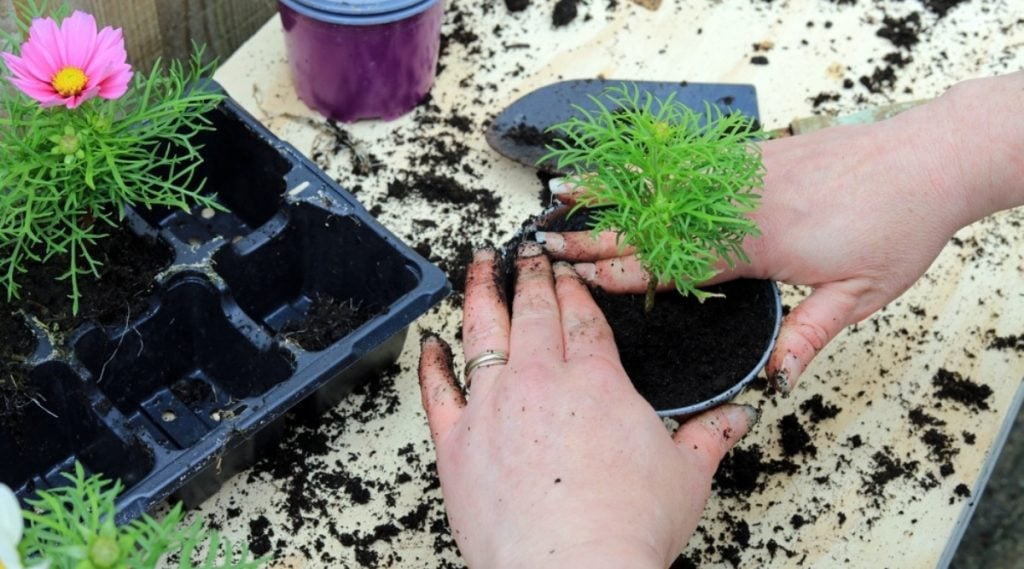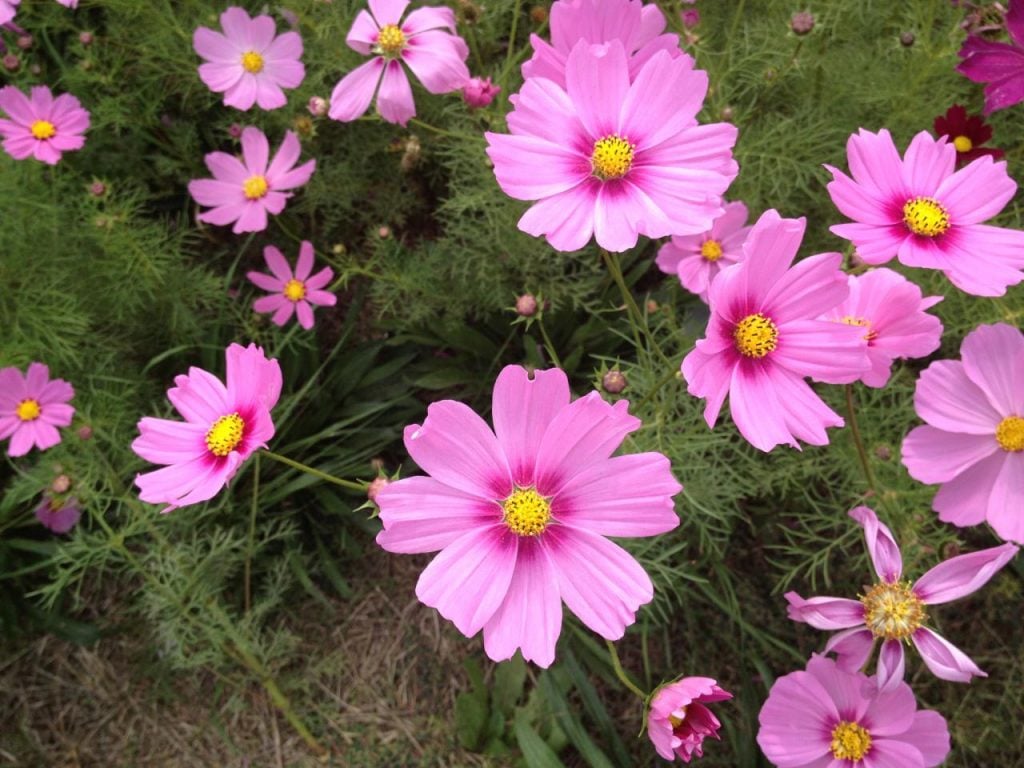How to Grow Cosmos Plants with Proper Care?

Table of Contents
Cosmos are rare annual flowering plants that you can add to your garden. They are commonly found across the European region, especially in the UK. Cosmos plants require proper maintenance, such as watering, trimming, and air circulation, to grow. Put their seeds in well-drained soil during the summer. It will keep its perfect shape until the autumn.
In this blog, you’ll learn about growing cosmos plants in the UK with proper care. Before you put them in your garden, you must understand a few important things about the flowering plant.
Scientific name: ‘Cosmos Bipinnatus’ or ‘Cosmos Sulphureus’
Height: 6 feet tall (max)
Soil: Well-Drained
Bloom Period: Summer
Flowers: Magenta, golden, pink, white, yellow, orange, and others
Cosmos plants are also popular as ‘Cut Leaf Cosmos.’ They share almost the same characteristics and require similar care as the Black-eyed Susan and Coneflowers. Here are the tips for growing them in your garden.
1. Basic Care to Grow Cosmos Plants

The first thing that you must consider before planting the seeds of cosmos plants is choosing the right time. Summer is the perfect time to plant them in your indoor garden. They are annual flowering plants that can bloom for an entire year. Putting a cosmos plant in your garden can add an appealing look to the landscape. If you want, you can grow them in a pot too. Just make sure it receives good air circulation and sunlight. Also, ensure that they are protected from the frost. Plant the cosmos when the temperature is not more than 24 degrees Celsius. It can help the cosmos plants to grow faster.
During the plantation process, provide a space for the cosmos seeds. Dig them deeply into the soil for about 8 inches. Then, cover them with the soil. Enable a space of around 2 inches for each seed. It may help them absorb proper sunlight and air. Keep watering them in the soil to strengthen their roots. Don’t forget to trim the extra leaves; it may help them in their development process. They grow in well-drained soil, so they maintain the drainage in the soil. Follow the basics to ensure adequate growth of the cosmos plants in your garden in the UK.
2. Proper Sunlight to Grow Cosmos

There are various types of cosmos plants available in the UK. You can plant any of them in your garden during the summer. It includes ‘garden cosmos’, ‘sulphur cosmos’, ‘pink cosmos’, ‘chocolate cosmos’, ‘cosmos concolour’, ‘picotee cosmos’, and others. Every cosmos plant requires proper sunlight and heat to grow. It may help them bloom fascinating flowers. As a result, the plants may establish a delightful and charming look in your garden. If you want to grow the cosmos plants in a pot, then put the pot in a lighted place. Make sure the plant is receiving full sunlight and heat. Try to avoid bright sunlight and overheating.
Overheating can damage the foliage of the plant. In addition, it will disrupt their growth process. Although, in a few regions, it survives the long heat. Summer is the right time to plant their seeds in your garden. During this time, they will be able to absorb the full sunlight, which is beneficial for their health. They will gain significant height until the end of the autumn. There are a few cosmos plants, such as the ‘Lace cosmos’ and ‘Sulphur cosmos’, that require more sunlight. So, if you want to add them to your garden, plant them in the late spring.
3. Appropriate Watering to Cosmos

Watering the plants is also as important as providing them with proper sunlight. Furnishing your plant with a regular watering process can increase its growth. In addition, it will help them remain healthy. An adequate watering method also protects them from getting rid of harmful insects. If you want to grow the cosmos plants in a pot, then provide water to them. For a few cosmos plants, you are required to provide water on a daily basis. It’s also beneficial for the soil. After planting them in the soil, provide space for each seed. Then, allow adequate watering for the plants. Be careful not to provide excessive levels of water.
For most cosmos plants, overwatering is not good for their growth. They generally prefer dry soil to grow. Thus, adding too much water can damage the soil’s moisture level. In addition, it can disrupt their growth. A cosmos plant grows when the humidity is high. Cosmos plants have over 25 species around the world. Proper watering ensures their adequate growth. Meanwhile, overwatering can disrupt their development process. It may damage the growth of their leaves and flowers. Thus, you can apply the water on a weekly basis.
4. Soil Care for Cosmos Plant

Choosing the right soil is very important for growing cosmos plants in the UK. It grows in well-drained soil with a neutral level of acid. Just make sure the soil pH level is around 6 to 8. Don’t let the soil warm more than 24 degrees Celsius. The cosmos plants may not be able to grow if the soil temperature is higher than usual. Keep the moisture level in the soil. As mentioned, there are over 25 cosmos plant species available in the world. They are also very familiar in the European region, even in the UK. You can grow any type of cosmos plant in your garden. One thing you must keep in mind is that not every cosmos plant shares the same characteristics. Not every cosmos flower grows in the same conditions and requires the same care.
There are also a few cosmos, such as ‘chocolate cosmos’, ‘garden cosmos’, and others, that prefer cool soil conditions to grow. Thus, they require more water than other cosmos plants. However, both grow in well-drained and rich soil with adequate moisture and a neutral pH level. In order to grow these types of cosmos, you must keep watering the soil frequently. So, choose your cosmos plants before you plant them in the garden.
5. Fertilising and Repotting

Fertilising is an important process for any kind of plant, whether it’s flowering or evergreen. However, the cosmos plants don’t require frequent fertilisation. They grow organically in well-drained soil. Just make sure the soil has a neutral acid level and a rich moisture level. Fertilisation is not mandatory for these types of plants. If you provide fertiliser, then it may not be beneficial for the cosmos flowers. Rather, it can damage the growth of the plant. Not only that, it can disrupt the development process of their roots, leaves, and flowers. They just require appropriate sunlight, warm humidity, and good air circulation to grow significantly.
Repotting is also not a mandatory process for cosmos plants. However, it has some benefits for this flowering plant. As mentioned, provide space while planting the cosmos seeds in the soil. Sometimes the soil fails to maintain the drainage level. It may disrupt the thickening of half of the plants. When you notice it, just remove half of the plant into another pot or another area. It may protect them from getting damaged. Repotting may be a time-consuming process, but it’s worth it for your plant. This process can also protect them from harmful insects and overwintering.
6. Pruning and Propagating

Pruning or trimming is necessary for the cosmos plants. It can increase the growth of the plants in your garden. Not only that, it may protect your plant from destructive aphids or pests. Sometimes, the cosmos plants require maintenance during their blooming season (autumn). At this time, some flowers or leaves may start to lose their glow. It indicates that the portion is damaged. So, you have to cut that portion out of the pot to protect the unaffected area. If you don’t do this, it may damage the entire body of the plant. As a result, they may not be able to bloom flowers effectively. Don’t forget the trimming process in the autumn.
Propagating the cosmos plants or seeds is essential after the frost. Sometimes the frosts damage so many parts of the plants, including their leaves and canes. Thus, propagation became a necessary process. Keep propagating the leaves along with the pruning process. You can apply the propagation method to the seeds before planting. It can help you increase the growth of their flowers. If you apply the propagation to the seeds before putting them in the soil, it can protect them from frosts in advance. There’s no need to speed up the growing process; you can do it with calmness.
7. Protection from Harmful Pests and Overwintering

Cosmos plants are popular flowering plants. They are famous for their beautiful flowers. Thus, aphids or other harmful pests easily attract them. They can damage the growth of the cosmos plant, including its leaves and roots. In order to get rid of them, you must ensure proper care. Cosmos don’t require any kind of fertiliser, and fertilisation is not good for their growth. They grow organically in nature. You can protect them from destructive pests without using any fertiliser. Just ensure you are providing them with proper sunlight, water, and air. In addition, use the pruning method to cut off the affected areas of the cosmos plants.
Not only the harmful pesticides but overwintering can also damage the growth of cosmos plants. It can disrupt the growth of the plant’s leaves and flowers. Sometimes the cold weather discolours the leaves, and if ignored, it can damage the entire plant. Trim the damaged leaves to protect your plant. It may prevent the spreading of discolouration to other leaves. Every so often, bacteria can damage the leaves and their foliage. Thus, to enable protection for your plants, keep providing them with adequate sunlight and water. In addition, don’t stop the pruning and propagating processes.
Get Flourishing Cosmos Plants in Your Garden!
All in all, growing a cosmos plant in your garden is easy. It may not require a high level of maintenance. Just provide them with the basic and necessary care to grow them in your garden. The perfect time to plant cosmos plants in the UK is in the summer. There are various types of cosmos plants you can add to your home.
You can sow the seeds in your outdoor garden or put them in a pot. Just one thing you must keep in mind is that not every cosmos plant has the same characteristics and grows under the same conditions. Cosmos plants produce a variety of flowers, such as magenta, pink, white, yellow, golden, and others.
Hopefully, this blog will assist you in learning some tips about growing cosmos plants with proper care. Follow the above steps and let us know what type of cosmos plants you are going to add to your garden.






